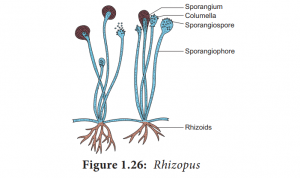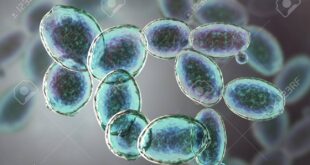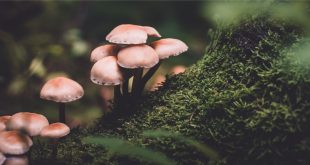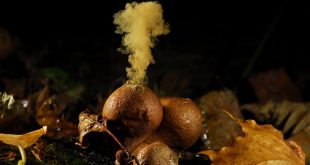The phylum Chytridiomycota contains five orders, 900 species and the single class Chytridiomycetes which contains a number of parasitic species.
At least two species in this class are known to infect a number of amphibian species.
These are the only members of the kingdom Fungi that produce motile cells at some stage in their life history. Except for a few species with polyflagellate cells, the motile cells (both zoospores and gametes) of these organisms each possess a single, posteriorly directed, whiplash flagellum.
Somatic features
- The vegetative thallus is coenocytic.
- Thallus may be spherical or cylindrical or elongated or ellipsoidal with or without rhizoids.
- They have rhizomycelium.
- They are both endobiotic and epibiotic.
- They are both holocarpic or eucarpic.
- The thallus may be monocentric or polycentric.

Best safe and secure cloud storage with password protection
Get Envato Elements, Prime Video, Hotstar and Netflix For Free
Best Money Earning Website 100$ Day
#1 Top ranking article submission website
Types of thallus structure in the Chytridiales
- Monocentric thallus: When the thallus/ chytrids produces single type of reproductive structure then it is called monocentric thallus.
- Polycentric thallus: When the thallus/ chytrids produces several or multiple types of reproductive structure then it is called polycentric thallus.
- Holocarpic: When full body or complete body of the thallus converted into one or more reproductive type of structure then it is called Holocarpic type of thallus.
- Endobiotic thallus: When complete thallus body presents within the host cell then it is called endobiotic thallus. e.g: synchytrium.
- Epibiotic thallus: The part which is present outside of the host cell then it is called epibiotic thallus. e.g: Chytriomyces.
Vegetative structure is completed then it grew into reproductive structure.
Rhizoids and Rhizomycelium
Rhizoid: short, delicate, filamentous or thread like structure and extension of thallus is called Rhizoid.  Source
Source
It helps in anchoring the substratum and absorption of nutrients.
- Unbranched rhizoids- Chitriomyces.
- Branched rhizoids- Rhizophydium.
Rhizomycelium: when many reproductive structures of the thallus are interconnected by much branched mycelium, then it is called Rhizomycelium e.g. Nowakowskiella elegans. It helps to interconnect the reproductive structures.
Reproduction of Chytridiomycetes
For most members of this class,sexual reproduction is unknown. Asexual reproduction occurs through the release of zoospores (presumably) derived through mitosis.
Single spore-complete body (Asexual).
Two gametes-complete body (Sexual)
Asexual reproduction
- By means of single posteriorly directed whiplash(without hair) flagellated zoospores.
- During early development, zoosporangia contain uncleaved (no divisions) protoplasm with many nuclei.
- The entire protoplast undergoes cleavege into numerous minute, typically uninucleate sections each of which develop into a posteriorly flagellate zoospores.
During asexual reproduction zoospores may-
- Discharge through papillae-Allomyces.
- Discharge through opercula (operculate)-Nowakowskiella.
- Discharge through pore or tube (inoperculate)-Synchytrium, olpidium.
Sexual Reproduction
There are 3 types of sexual reproduction in the class Chytridiomycetes-
1. Planogametic copulation.
2. Gametangial copulation.
3. Somatogamy.
1) Planogametic copulation:
- Conjugation of isogamous planogametes-Synchytrium.
- Conjugation of anisogamous planogametes-Allomyces.
- Fertilization of a non motile female gamete by a motile male gamete (heterogamous)-Monoblepharis.
2) Gametangial copulation:
In the chytrids, this is accomplished by transfer of the entire protoplast of one gametangium into ther other (in case of unfavorable condition) – Rhizophydium, Zygorhizidium, Planktonicum.
- Plasmogamy means fusion of protoplasm.
- Chariogamy means fusion of nuclei.
3) Somatogamy:
Somatogamy is simply the fusion of the somatic structure.In some chytrids, fusion between rhizoidal filaments precedes the formation of a resting spore. e.g: Chytriomyces hyalinus.
The resting spore
- The result of sexual reproduction is the production of resting spore (after zygote formation).
- Guttulate and thick walled.
- Colorless or light to dark shades of yellow or brown.
- In some chytrids, a thin walled zoosporangium is formed.
- Planogametes or zoospores discharge through exit papillae, tube/ pore or opercula.
Spherical-Synchytrium
Pear-Nowakowskiella - Each zoospore may give rise to a new thallus. e.g. Nowakowskiella macrospora, Synchytrium etc.
Salient features of Chytridiomycetes
- One of the most representative characteristics is the production of motile cell (in case of both zoospores and planogametes).
- Zoospores with single posteriorly directed whiplash flagellum.
- Coenocytic structure of the thallus with multinucleate globose or oval structures.
- Simple elongated hyphae or well developed mycelium.
- They are unicellular, holocarpic or eucarpic.
- Zygote produce resting spore or resting sporangium.
- Cell wall made of chitin.
- They live in both aquatic and terrestrial habitats.
- Most species are saprophytic and some are parasitic.
- Asexual reproduction by means of zoospores.
- Sexual reproduction by means of planogametic copulation, gametangial copulation and somatogamy.
Economic significance or harmful effect of Chytridiomycetes
- Black wart disease of potato- Synchytrium endobioticum (pathogen).
- Gall disease of Clerodendrum viscum (Bhat)-Synchytrium collapsum (pathogen).
- Brown spot of corn-Physoderma maydis.
- Olpidium seeding blight, root burn disease of cabbage-Olpidium brassicae.
- Parasite on Spirogyra sp. Rhizophydium couchii.
- Vector for a number of plant viruses-Olpidium brassicae.
- A parasite of leaves and stems of Vicia unijuga–Olpidium viciae.
Order: Chytridiales
- Unicellular thallus body.
- Mostly aquatic.
- Both holocarpic and eucarpic.
- Endobiotic.
- Monocentric and polycentric type of thallus.
- Motile gametes and zoospores present.
- Zoospores bear a single conspicuous oil globule.
Family: Synchytriaceae
- Unicellular thallus body.
- The thallus is endobiotic and holocarpic.
- Monocentric thallus body (reproductive structure creator).
- At reproduction the thallus may be converted directly into a group (or sorus) of sporangia.
- Sexual reproduction is by copulation of isogametes, resulting in the formation of thick walled resting sporangia.
Symptoms of Black wart disease of potato
- Usually the disease affects the underground parts of the host.
- Diseased potato tubers appear as dark brown or black cauliflower like outgrowths.
- The fungus causes the enlargement of the surface cells (hypertrophy) as well as increased the numbers of cells(hyperplasia) in the infected potato tuber, converting them into useless masses of warty tissue.
- Most of the host cells contain resting sporangia.
- Galls or tumors may be formed on aerial parts (stems and leaves ).

Fig: Black wart disease of potato Source
The Aquatic Fungi
The Chytridiomycetes is denoted as aquatic fungi because it disperses through water with motile spores. Members are found in soil, fresh water and saline estuaries.
They are first known from the Rhynie chert. One-celled members of the Chytridiomycota live in either intracellular or epibiotic parasitic association, mostly with algae, occasionally with other Chytridiomycota or Oomycota, and rarely with Zygomycota.
Reference
This Article is completely based on by the lecture of Sorwar Hossain, Lecturer, Department of Botany, University of Dhaka.
Some info and pictures have been added by author.
Reference used for info: Introduction To Mycology by Alexopoulos.
 Plantlet The Blogging Platform of Department of Botany, University of Dhaka
Plantlet The Blogging Platform of Department of Botany, University of Dhaka






Well organised info’s make it so much interesting to complete. Supportive images may be added for comfort.
Some of the technical problems that you need to solve
The point of view of your article has taught me a lot, and I already know how to improve the paper, thank you.